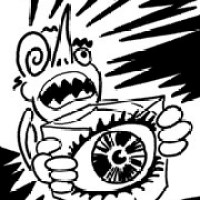Jack Kirby’s In The Days Of The Mob
Recently released in hardcover for the first time by DC Comics, Jack Kirby's "In The Days of the Mob" was a curious deviation from DC Comics' usual publication style when it hit stands in 1971. Jack Kirby advocate, Rand Hoppe, takes a look at the book and its strange, short publication history.
As part of their nearly exhaustive Jack Kirby publishing program, DC Comics has published a hardcover edition of In the Days of the Mob featuring all of Kirby’s work for the title. In 1971, DC’s precursor, National Periodical Publications published half of this material in one issue of an ill-fated magazine, part of a “Speak-Out Series” with Kirby’s Spirit World, under the imprint “Hampshire Distributors, Ltd”.
In that first In the Days of the Mob issue, its cover cluttered with a Kirby sepia photo montage and small illustrations reminiscent of pulpy, old-timey scandal mags, Kirby introduced Warden Fry, a sinister, supernatural warden in a hell-jail, who acted as host to the stories. Kirby told tales of Ma Barker and her sons, Al Capone vs. Thomas Dewey, the Kansas City Massacre featuring Pretty Boy Floyd, and Alvin Karpis a.k.a. Country Boy. Surprisingly, all were stories he told previously in the late 1940s when crime comics were at the height of their popularity. Vince Colletta inked and John Costanza lettered Kirby’s work. The art was uniquely presented using wash tones, but the artist who produced the tones remains a mystery. While doubtful, some scholars think Kirby did the work. More likely candidates include Colletta, National colorist Jerry Serpe, or production man Jack Adler. Sergio Aragones provided some comic relief for two pages. Steve Sherman and Mark Evanier offered short text and fumetti features. Also included was a John Dillinger “Wanted” poster and a Kirby photo collage on the table of contents.
Included in the new hardcover is the work Kirby produced for the second issue. Inked and lettered by Mike Royer, a big fan of Kirby’s self-inked 1940s crime comics, Kirby told tales about Murder, Inc., MI’s hitman Kid Twist, the mob ladies, and “The Ride.” Prime Kirby/Royer, some stories have made their way to the public via the likes of the John Morrow’s Jack Kirby Collector and National’s house fanzine The Amazing World of DC Comics.
So what’s the story with In the Days of the Mob? Why did National/DC publish black and white magazines?
Consider this: it’s 1971 and the King of Comics, Jack Kirby, is a few months into his employ by Carmine Infantino at National with the mission to revitalize the company’s line, and possibly the entire comics industry. After all, the thinking went, Kirby had pumped adrenaline into costumed heroes with his partner Joe Simon on Captain America for Martin Goodman in the early 1940s. Later, Kirby and Simon introduced the successful kid gang comics and lucrative romance comics trend. And most recently, Kirby merged costume heroes, kid gangs, and romance comics with mind-blowing techno-cosmic goodness for Stan Lee and Martin Goodman at Marvel Comics. Who but Kirby to change the course of the comics industry again?
Kirby and Infantino, seeing trouble for the four color booklet at the newsstand with no recent hits for any comics company, looked into formats National wasn’t publishing. Jim Warren’s Eerie and Creepy black and white magazines offered the horror comics that were clamped down on nearly twenty years previously by the Senate Subcommittee on Juvenile Delinquency hearings and the establishment of the Comics Code. Bill Gaines’ Mad magazine was also doing well out from under the Code. Perhaps considering the recent success of Arthur Penn’s 1969 movie Bonnie and Clyde with its at-the-time hyper-violent ending, as well as the concurrent filming by Francis Ford Coppola of Mario Puzo’s best-selling novel The Godfather starring the then-elusive star, Marlon Brando, Infantino green-lit Kirby’s return to the also-neutered-by-the-Comics-Code crime comics, for an In the Days Of The Mob black and white magazine.
Not that In the Days of the Mob was anything new for Kirby. As mentioned above, he’d produced crime comics a little more than twenty years earlier in his studio with Joe Simon. What was new was the format. National had never produced a magazine before, nor had it produced anything that wasn’t approved by the Comics Code. So, to maintain National’s wholesome “Superman” brand, the imprint “Hampshire Distributors, Ltd..” was created.
Unfortunately, the magazine and its sibling publication Spirit World were dead in the water. Was it due to to National not knowing how to perform in the magazine space? Or to National’s sibling company Independent News not knowing what to do with this kind of magazine? Or to the appearance of an unknown imprint offering such material? probably a combination of all three. National soon, unprecedentedly, offered the magazine for mail order from “Hampshire” in some of its comics. Had In the Days of the Mob been on the stands around the March 1972 release of Coppola’s movie, it might have enjoyed a different fate, but with a ”Fall 1971” in its indicia, it would have been long removed from the racks by then.
Special thanks to Harry Mendryk’s entry about In the Days of the Mob, which you can read right here!
Like us on Facebook and follow us on Twitter for all news updates related to the world of geek. And Google+, if that’s your thing!
